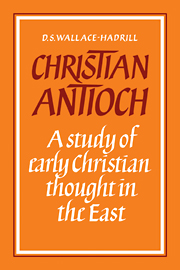Book contents
- Frontmatter
- Contents
- Foreword
- Abbreviations
- Introduction: survey of the history of Antioch
- 1 The religious background to Antiochene Christianity: pagan, Jewish, gnostic
- 2 The interpretation of the biblical record
- 3 Historiography in the Eastern Church
- 4 The doctrine of the nature of God
- 5 The use of Greek philosophy by the Eastern Church
- 6 The human experience of Christ and the salvation of man
- 7 Antiochene theology and the religious life
- Appendix 1 Eastern representation at Nicaea
- Appendix 2 The feminine element in Syrian Christianity
- Notes
- Bibliography
- Index
Introduction: survey of the history of Antioch
Published online by Cambridge University Press: 03 May 2010
- Frontmatter
- Contents
- Foreword
- Abbreviations
- Introduction: survey of the history of Antioch
- 1 The religious background to Antiochene Christianity: pagan, Jewish, gnostic
- 2 The interpretation of the biblical record
- 3 Historiography in the Eastern Church
- 4 The doctrine of the nature of God
- 5 The use of Greek philosophy by the Eastern Church
- 6 The human experience of Christ and the salvation of man
- 7 Antiochene theology and the religious life
- Appendix 1 Eastern representation at Nicaea
- Appendix 2 The feminine element in Syrian Christianity
- Notes
- Bibliography
- Index
Summary
The name ‘Antioch’ can denote three different areas: the walled city; the administrative region, comprising the surrounding countryside and its villages, extending perhaps as far as fifty miles from the city; the ecclesiastical diocese, whose vast extent is shown on the map. This brief introductory survey is confined largely to the city. Succeeding chapters will spread wider to embrace cultural centres elsewhere in the diocese. The administrative region surrounding the city is not directly treated at all.
The geographical location of Antioch was in part the cause of its wealth and importance and was in part the cause of its eclipse. It was built in a fertile, well-watered region which controlled an important network of roads linking east with west and north with south. It was, however, situated on a geological formation which made it prone to severe earthquakes and the eventual southward extension of the city up the slopes of Mount Silpius rendered it dangerously vulnerable to attack from above. The combination of repeated destruction by earthquakes and the skilful use of the higher slopes of the mountain by the Persian invaders in the sixth century A.D. and the Arab invaders in the seventh ensured that despite its great commercial and military importance the rôle of Antioch as the key city of the eastern empire could not survive indefinitely.
- Type
- Chapter
- Information
- Christian AntiochA Study of Early Christian Thought in the East, pp. 1 - 13Publisher: Cambridge University PressPrint publication year: 1982

